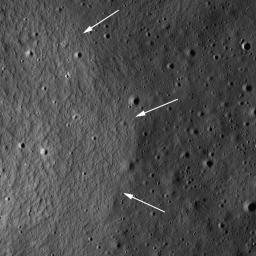
|
Remnants of the Imbrium Impact
- Click the image above for a larger view
- Full-Res JPEG (1000 x 1000) (156.7 kB)
- Full-Res TIFF (1000 x 1000) (1.0 MB)
Caption:
Mare basalts embayed ejecta structures formed by the massive Imbrium impact in LROC NAC image M131501983R. Arrows denote the contact between younger mare basalts and older Imbrium ejecta, image width is 902 meters, or 2959 feet.
Mare basalts fill most of the large impact basins on the Moon, and in many cases the pre-existing topography was buried by the huge outpourings of lava. However, sometimes pre-existing topography is not completely buried by the mare basalts. When lava flows around a topographic high and does not bury it completely, the resulting landform is called a kipuka , and may be used to tell scientists about the region before the lavas flowed across the landscape. This kipuka in southwestern Lacus Somniorum is probably ejecta from the impact that formed the Imbrium basin. When looking at a regional view, this knob and others form relatively linear chains which can be traced back to the Imbrium basin.
Cataloging Keywords:
| Name | Value | Additional Values |
|---|---|---|
| Target | Moon | |
| System | Earth | |
| Target Type | Satellite | |
| Mission | Lunar Reconnaissance Orbiter (LRO) | |
| Instrument Host | Lunar Reconnaissance Orbiter | |
| Host Type | Orbiter | |
| Instrument | Lunar Reconnaissance Orbiter Camera (NAC) | |
| Detector | ||
| Extra Keywords | Grayscale, Impact | |
| Acquisition Date | ||
| Release Date | 2010-08-03 | |
| Date in Caption | ||
| Image Credit | NASA/GSFC/Arizona State University | |
| Source | photojournal.jpl.nasa.gov/catalog/PIA13504 | |
| Identifier | PIA13504 | |
